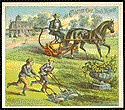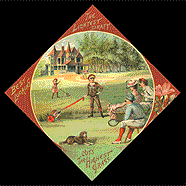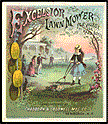|
|
|||||||||||||||||||||
|
|
|||||||||||||||||||||
|
|
|||||||||||||||||||||
|
|
|||||||||||||||||||||
|
by Ben Crane |
|||||||||||||||||||||
|
|
|||||||||||||||||||||
|
The idea of a machine to cut grass was conceived in Gloucestershire, England around 1830 by freelance engineer Edwin Beard Budding. Formerly a carpenter at Chalford, he was possibly inspired by a rotary cutter designed to cut the nap off wool cloth at the Brinscomb Mill. Budding's mower was designed primarily to cut the lawn on sports grounds and expansive gardens as a superior alternative to the scythe. His patent of 25 October, 1830 described "a new combination and application of machinery for the purpose of cropping or shearing the vegetable surfaces of lawns, grass-plats and pleasure grounds." The patent went on to state, "country gentlemen may find in using my machine themselves an amusing, useful and healthy exercise." The rise in popularity of sports such as lawn tennis, croquet, cricket, football and rugby helped prompt the spread of the invention. Lawn mowers became a more efficient alternative to simply relying on gardeners wielding the scythe (which left unsightly circular scars) or bare spaces caused by domesticated grazing animals. [this and previous paragraph from Wikipedia, the free encyclopedia]. The first United States patent for a reel lawn mower was granted to Amariah Hills on January 12, 1868. Early lawn mowers were often designed to be horse drawn, the horses often wore oversize leather booties to prevent lawn damage. In 1870, Elwood McGuire of Richmond, Indiana designed a very popular human pushed lawn mower, not the first to be human pushed, however, McGuire's design was very lightweight and a commercial success. [from Greener Pastures, by Mary Bellis]. These early machines were all made of cast iron and featured a large rear roller with a cutting cylinder (reel) in the front. Cast iron gear wheels transmitted power from the rear roller to the cutting cylinder. Overall, these machines were remarkably similar to modern mowers. The next major innovation in lawn mower design was the introduction of the sidewheel machines. Although invented in England, these machines were popular in North America where grasses are often coarser than in Europe. They had cast iron wheels at each side which drove the cutting cylinder directly by means of ratchets inside the castings. They did not have a metal rear roller, and were very light and inexpensive to make, which made them very popular all over the world. [this and previous paragraph from The Old Lawn Mower Club] The lawn mowers advertised by the 20 trade cards shown below were manufactured by American companies, probably from 1880 to 1900. Most of these cards show the mower being pushed by a child or woman. This is typical of lawn mower trade cards, emphasizing how easily the mower can be operated. Six of the mowers shown are of the older roller design, and the rest are the newer sidewheel machines. Card 12 advertising the President Lawn Mower shows the superiority of a roller mower over cutting grass by hand with a scythe or sickle, and Card 14 advertising the Pennsylvania Lawn Mower shows the superiority of the sidewheel mower over the roller mower. Shown below are thumbnail images (at 25 percent of actual size) of these trade cards. Click on a thumbnail for a larger view, or click here to begin viewing the cards in slide show fashion. |
|||||||||||||||||||||
|
|
|||||||||||||||||||||
|
|||||||||||||||||||||
|
|
|||||||||||||||||||||



















